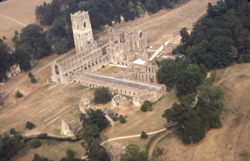|
|
You are here:
Expansion throughout Britain and Ireland
(1/6)
Map of Cistercian abbeys
in England
 |
With the foundation of Rievaulx in
1132, and Fountains soon
after, the Order flourished. The eight Yorkshire houses formed
a
unique stronghold in the North from where the Cistercians could
infiltrate the country. The speed and extent of their expansion
was quite remarkable, and testimony to the tremendous appeal of
the White Monks. Their poverty and sanctity attracted donors and
recruits, for people wanted to be involved with these monks, whose
way of life guaranteed the surest way to heaven. The Cistercians
were also an attractive financial proposition to founders, for
it
was less costly to establish a community of White Monks whose
requirements were so simple. The appeal of the Cistercians was
also helped by
the fact that they had royal backing - both Henry I and David
of Scotland had shown their support for the monks, and others followed
their example. 1147, the Golden Year of the Order, was also the
highpoint of Cistercian expansion in Britain. Nine houses were
founded
in England at this time, and more were incorporated through the
absorption of the Savigniac
Congregation.(1)
|
|
Most foundations stemmed from Waverley,
Fountains and Rievaulx,
and the Clairvaux line dominated in Britain, as in Europe. Waverley
scattered its seeds throughout the South and Midlands, Rievaulx
through Lincolnshire and Scotland, and Fountains in the eastern
counties and Yorkshire; monks from Fountains reached as far afield
as Norway, and colonised the abbey of Lyse,
near Bergen, in 1146.
Cistercian expansion in England
was effectively completed by c. 1150, although there was a resurgence
from the thirteenth century, with the foundation of several royal
abbeys - Beaulieu, Netley,
Vale Royal, Hailes,
Newenham, and St
Mary Graces. Expansion in Scotland continued throughout the
twelfth century, but the main area of growth at this time was in
Wales.
|








